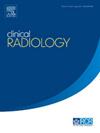使用冠状动脉计算机断层血管造影(CCTA)预测冠状动脉斑块,重点关注新发、高风险和阻塞性斑块
IF 1.9
3区 医学
Q2 RADIOLOGY, NUCLEAR MEDICINE & MEDICAL IMAGING
引用次数: 0
摘要
目的:建立并验证基于ccta衍生的脂肪衰减指数(FAI)的预测模型,预测新的、高风险的和阻塞性斑块的形成。材料与方法本研究回顾性纳入160例有心血管危险因素的患者进行模型开发,60例患者进行外部验证。所有患者在5年内至少进行了两次CCTA检查,初步结果正常。评估新形成的斑块及其易损性和管腔狭窄。通过初始CCTA定量评估三条主要冠状动脉的FAI。结果在160名参与者中,60名患者中发现了新形成的斑块。FAI在预测新发(曲线下面积(AUC) 0.723 [95% CI: 0.645, 0.802],其临界值为-80.5 HU,敏感性为73.3%,特异性为64.0%)、高危(AUC 0.822 [95% CI: 0.715, 0.929],其临界值为-78.5 HU,敏感性为90.9%,特异性为65.3%)和梗阻性(AUC 0.823 [95% CI:0.720, 0.926],临界值为-77.5 HU,敏感性为90.0%,特异性为74.0%)斑块,与常规临床危险因素相比呈现递增值(0.817 vs 0.749;0.862 vs. 0.700;0.876 vs 0.740,均为P <;0.001)。结论FAI和心血管危险因素有助于预测冠状动脉斑块形成的概率(FAI: -80.5 HU),尤其是高风险(FAI: -78.5 HU)和阻塞性(FAI: -77.5 HU)斑块。本文章由计算机程序翻译,如有差异,请以英文原文为准。
The use of coronary computed tomography angiography (CCTA) to predict coronary artery plaque, with a focus on new, high-risk, and obstructive plaques
AIM
To develop and validate a predictive model based on CCTA-derived fat attenuation index (FAI) for the formation of new, high-risk, and obstructive plaques.
MATERIALS AND METHODS
This research retrospectively included 160 patients with cardiovascular risk factors for model development and 60 patients for external verification. All patients underwent at least two CCTA examinations within a 5-year period, and initial results were normal. Newly formed plaques, along with their vulnerability and luminal stenosis was assessed. The FAI was quantitatively evaluated on the three major coronary arteries with the initial CCTA.
RESULTS
Among 160 participants, newly formed plaques were identified in 60 patients. FAI had a certain value in predicting new (area under the curve (AUC) 0.723 [95% CI: 0.645, 0.802], with a cut-off value of -80.5 HU, sensitivity of 73.3% and specificity of 64.0%), high-risk (AUC 0.822 [95% CI: 0.715, 0.929], with a cut-off value of -78.5 HU, sensitivity of 90.9% and specificity of 65.3%), and obstructive (AUC 0.823 [95% CI: 0.720, 0.926], with a cut-off value of -77.5 HU, sensitivity of 90.0% and specificity of 74.0%) plaques and exhibited an incremental value compared with conventional clinical risk factors (0.817 vs 0.749; 0.862 vs. 0.700; 0.876 vs 0.740, all P < 0.001).
CONCLUSION
FAI and cardiovascular risk factors aided in predicting the probability of coronary plaque formation (FAI: -80.5 HU), especially high-risk (FAI: -78.5 HU) and obstructive (FAI: -77.5 HU) plaques.
求助全文
通过发布文献求助,成功后即可免费获取论文全文。
去求助
来源期刊

Clinical radiology
医学-核医学
CiteScore
4.70
自引率
3.80%
发文量
528
审稿时长
76 days
期刊介绍:
Clinical Radiology is published by Elsevier on behalf of The Royal College of Radiologists. Clinical Radiology is an International Journal bringing you original research, editorials and review articles on all aspects of diagnostic imaging, including:
• Computed tomography
• Magnetic resonance imaging
• Ultrasonography
• Digital radiology
• Interventional radiology
• Radiography
• Nuclear medicine
Papers on radiological protection, quality assurance, audit in radiology and matters relating to radiological training and education are also included. In addition, each issue contains correspondence, book reviews and notices of forthcoming events.
 求助内容:
求助内容: 应助结果提醒方式:
应助结果提醒方式:


